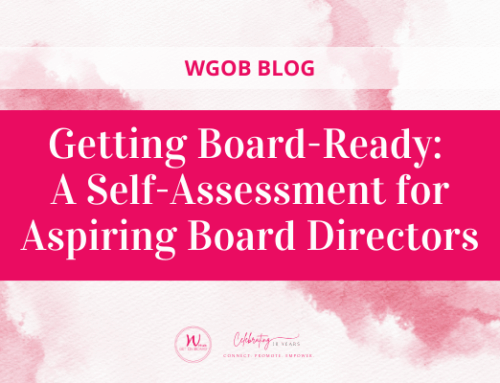Standards and frameworks for executive compensation in Canada are always evolving. So, what should board members know about executive compensation trends in 2024?
To answer that question, Women Get On Board Inc. (WGOB) hosted a virtual discussion on June 20, sponsored by Southlea Group, as part of the WGOB Speaker Series. Leveraging Southlea’s role in the Global Governance and Executive Compensation and Governance Group (GECN), the event explored the latest compensation trends amongst the S&P/TSX 60 companies across Canada in terms of compensation levels, incentive design and other governance features.
Dr. Deborah Rosati, FCPA, FCA, ICD.D, GCB.D, CCB.D, Corporate Director and WGOB Founder and CEO, introduced Amanda Voegeli, President & Managing Partner, Southlea Group and Alex Pattillo, Partner, Southlea Group to share their analysis.
The state of executive compensation in Canada
Amanda kicked off the conversation by asking the question on many board members’ minds.
“Is CEO pay in Canada a runaway train?”
According to Southlea Group’s analysis, that appears not to be the case. The total direct compensation of CEOs at S&P/TSX 60 companies across Canada has remained relatively flat since 2021, hovering around the $10 million region. The most notable changes have been in the long-term incentive plan (LTIP) component, which has increased in value slightly over the past three years.
As part of the discussion, Amanda also highlighted a notable change in short-term incentive plans (STIP). While shorter-term incentive payouts fell to normal levels in 2023, the 2021 and 2022 payouts were significantly higher than target. She explained that the abnormal levels were due to the impact of the Covid-19 pandemic. The lesson learned from the data? More shock testing should be conducted on financial and operating measures to account for unexpected events such as a pandemic.
Alex highlighted a range of other factors that are impacting the current state of executive compensation in Canada.
“One of the influences on 2024 budget setting is voluntary turnover,” he said.
As most board members know, 2023 was a tough year for the executive talent market. Inflation, rising interest rates, and strong demand all impacted the talent market, leading to a surge in voluntary turnover that was as high as 11% over median. However, that rate has started to come down recently. Alex said that he expects the fall in voluntary turnover to lead to a corresponding softening in salary budgets.
In terms of incentive design, Southlea’s analysis showed very little year over year change—which is sensible, considering that most executive pay programs have been developed to be enduring. Currently, the industry standard is a scorecard design that includes a variety of measures.
Most designs continue to place the highest weight on financial measures, as they are critical indicators of the successful execution of the business strategy. However, we are also seeing certain non-financial measures such as ESG become more common in recent years.
There has also been little evolution in the design of long-term incentives. But while the data shows few changes in the mix in LTIPs, Amanda noted that there is continued pressure on the use of stock options. As an alternative to stock options, Amanda and Alex suggested that boards consider extending the vesting of the LTIP beyond three years.
Similarly, there has been pressure from investors to increase the number of measures in PSU design, and companies have been carefully considering how to ensure their design aligns with the company’s strategy and reflects the market. 69% of companies in the analysis now have two or more measures in their PSU design.
The rise of ESG measures
The prevalence of ESG measures in executive compensation plans is on the rise worldwide. In Canada and the US, 2023 marked a sharp uptick, with 75% of Canadian companies and 78% of American companies including ESG measures in their incentives.
In other regions the rates are closer to 90%, but Amanda and Alex noted that this difference is mainly due to differing regulations and political realities.
In Canada, the frameworks for such measures vary. Some companies articulate clearly disclosed measures and targets in the STIP, while others integrate ESG as a designated section of their scorecard. Certain companies integrate ESG measures into both their short- and long-term plan to provide a combination of incentives.
Changes for governance
2024 marked a few notable news items in governance with regards to executive compensation.
Say on pay results for 2024 were positive in Canada, with 52% of Canadian companies receiving more than 95% approval, compared to only 20% of American companies. The difference is likely due to a combination of factors, including the lower pay levels in Canada, lower levels of investor activism, and the high levels of transparency from Canadian companies.
Other influences on executive pay governance included announcements from Glass Lewis on changes to how they evaluate different programs—including how they view claw back policies—and the changes to the Globe and Mail’s “Board Games”.
Five predictions for 2024
As part of the conversation, Amanda and Alex shared Southlea Group’s five predictions for executive compensation for 2024 that they made at the beginning of the year.
Evolution of Share Ownership Policies: The Canadian Coalition for Good Governance (CCGG) issued a paper in 2023 that indicated this would become a hot topic.
Reconciliation of Adjusted Measures: The recent ISS and Glass Lewis reports both paid substantial attention to this topic in 2023.
Quantification of ESG Measures: Companies are predicted to continue improving on ESG measurement as time goes on.
Pressure on Directors’ Pay: Attention appears to be returning to directors’ pay at many companies.
Pay vs. Performance Evaluation: A new required disclosure rule in the U.S. with rigorous standards may also impact companies in Canada.
As the year progresses, many of these issues are continuing to play a key role in the conversation around executive compensation in Canada. For more on these trending topics, review the CCGG report.
Don’t miss our next virtual WGOB Speaker Series event on August 22, which explores the role of Advisory Boards in 2024, drawing on trends from the Advisory Board Centre’s 2023 – 2025 State of the Market Report. Click here to register now.






